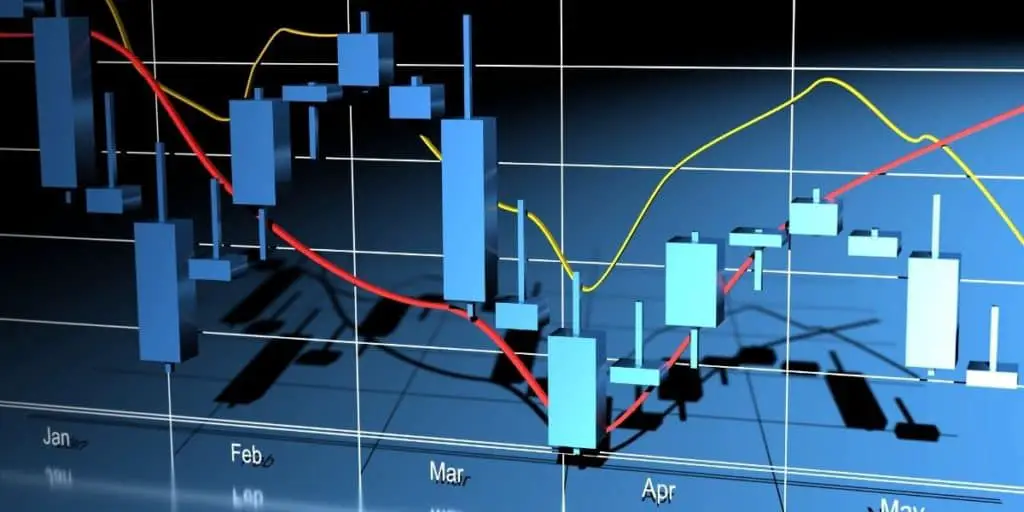Professional traders have an arsenal of tools at their disposal, and the moving averages indicator is just one of those tools. Because the stock market is all about timing and moving averages provide information at the macro level, successful traders must be familiar with their stock’s moving average. But do professional traders use moving averages?
Professional traders use moving averages to get a better picture of a stock’s performance without distractors. The moving average also allows traders to see who’s in control of the stock: buyers or sellers. Most traders combine moving averages with other indicators, like Bollinger Bands.
In the rest of the article, we will learn a bit more about moving averages, alongside the certain advantages and disadvantages of using them to make informed trading decisions. Furthermore, to help you improve the reliability of trade signals generated by moving averages, I will also share examples of some complementary indicators that work great in conjunction with moving averages.
IMPORTANT SIDENOTE: I surveyed 1500+ traders to understand how social trading impacted their trading outcomes. The results shocked my belief system! Read my latest article: ‘Exploring Social Trading: Community, Profit, and Collaboration’ for my in-depth findings through the data collected from this survey!
Table of Contents
What Are Moving Averages?
Moving averages are snapshots of a stock or security’s average price over a specific time range at various points in time, with prices charted by a statistician or perhaps by investors themselves. These snapshots help investors monitor or possibly discover trends that help them decide when to buy, sell, or hold shares. Moving average periods are typically in increments of 20, 50, and 200 periods. These periods are often days but can be minutes or hours.

It’s important to note that moving averages only provide information on past performance, so they’re limited in scope. They’re beneficial because they reduce the impact of outliers during decision-making and help traders focus on trends, but again, they’re only one tool.
How To Use Moving Averages?
Moving averages can be tailored to suit both long-term and short-term traders because they work best to show traders a broad picture of what stock prices are doing. However, moving averages aren’t a “one-size-fits-all” indicator, as is the case with everything else in the stock market.
Several types of moving averages are available for you to consider based on your overall goal:
- Simple Moving Average (SMA) deals with stock prices with equal weightage assigned to price at each time increments. Day traders find this average most helpful.
- Weighted Moving Average (WMA) is calculated by assigning higher weight values to more recent prices. Traders who use this average argue that it’s more accurate than the SMA because current prices are a more robust indicator of what the stock may do since the current price has market context in consideration.
- Exponential Moving Average (EMA) is also a type of weighted moving averages but differs in the sense that the reduction in weightage assigned to one price point versus the other is not consistent. EMAs often works best for short-term trading strategies because it focuses on recent prices rather than long-term averages, making it quicker to react to changes.
Benefits of Knowing the Moving Average
Aside from using this indicator to decide when to buy, sell, or hold, moving averages are necessary to understand because many of the concepts traders rely on, such as divergence and confirmation, are based on moving averages. Understanding how they work informs how other indicators and concepts work.
The main benefit of being familiar with the moving average is because this knowledge helps traders better determine an accurate picture of the stock’s performance without distractors. Mainly, traders look at the moving average to determine who’s in control of the stock. For example, buyers are in control when the stock is trading above the moving average. Conversely, sellers are in control when the prices are trading below the moving average.
Problems With Moving Averages
The main problem with relying on moving averages is that this indicator gives past market data; therefore, it cannot predict future prices. Too many other things impact the market, such as new competition in the stock’s market, a change in supply and demand for products or services, and management changes in companies for historical pricing alone to be the main factor used in deciding to move (or not move) on a stock.
This data is helpful but insufficient by itself.
Another downfall of moving averages is they work best in an up and down market, meaning that they’re only helpful when the market is trending strongly. So the benefits of using market averages are limited from the start.
The problem with using moving averages is that they cannot gauge particularly volatile companies. The prices in these companies sometimes move too drastically for the moving average date to be accurate. So, while the moving average indicator is informative, traders cannot rely on them in isolation.
Other Indicators To Pair With Moving Averages
So far, we’ve established that few people would consider using a single tool or indicator for any decision, mainly when profits or losses are at stake. So, while professional traders use moving averages, a helpful exercise is investigating what they pair that indicator with and why.
Electing to use any (or all) of the following tools in conjunction with the moving averages indicator to understand better what the stock price is doing is a solid strategy to adopt:
- Average True Range measures the volatility of a currency pair. Understanding market volatility and using it accordingly is what can create solid returns for investors. For context, an increase in volatility indicates a market reversal while a decrease indicates continuation.
- Bollinger Bands measure moving averages to indicate a trading entry point. The upper band is the dynamic support, and the lower band is the resistance level. Traders look to see if there’s a rejection or breakout from these levels and trade accordingly.
- Ichimoku Cloud measures market context and indicates a bearish or bullish market. There are several elements in this indicator, the first being the Kumo Cloud, which helps understand the market context. Arguably, you should use this indicator with each decision. When prices are above the cloud, the trend is positive; if below, the trend is negative.
- Fibonacci is arguably the most accurate indicator when used with others as it shows the direction of the average as it relates to all other occurrences. Although beyond the scope of this article, Fibonacci uses what’s referred to as “the golden ratio” to identify market reversal.
- MACD calculates price divergence to indicate market continuations and reversals so traders can get in or out of the stock as required.
- Pivot Point is predictive. It uses high, low, and closing prices to indicate the prices that the company’s stock rarely goes below (support) and the price it cannot seem to pass (resistance).
- Relative Strength Index indicates at what point the stock prices are likely to reverse.
- Stochastic Oscillator is a momentum tool most used to indicate at what point price will reverse based on the overbought and oversold zones.

These indicators are popular because they provide a starting point for making decisions. However, neither the stock market nor its prices operate in a vacuum. Therefore, while averages and formulas are tremendously important, professional traders never lose sight of the big picture of the market.
Indicators help traders understand numbers and should be considered by professional and novice traders alike. Still, it takes an overall understanding of the happenings in the world — from weather and health to holidays and military activity — to arrive at the best decision. Novice traders often like the comfort they get from seeing what’s happening on charts but cannot neglect what’s happening outside Wall Street that’s impacting the market.
Author’s Recommendations: Top Trading and Investment Resources To Consider
Before concluding this article, I wanted to share few trading and investment resources that I have vetted, with the help of 50+ consistently profitable traders, for you. I am confident that you will greatly benefit in your trading journey by considering one or more of these resources.
- Roadmap to Becoming a Consistently Profitable Trader: I surveyed 5000+ traders (and interviewed 50+ profitable traders) to create the best possible step by step trading guide for you. Read my article: ‘7 Proven Steps To Profitable Trading’ to learn about my findings from surveying 5000+ traders, and to learn how these learnings can be leveraged to your advantage.
- Best Broker For Trading Success: I reviewed 15+ brokers and discussed my findings with 50+ consistently profitable traders. Post all that assessment, the best all round broker that our collective minds picked was M1 Finance. If you are looking to open a brokerage account, choose M1 Finance. You just cannot go wrong with it! Click Here To Sign Up for M1 Finance Today!
- Best Trading Courses You Can Take For Free (or at extremely low cost): I reviewed 30+ trading courses to recommend you the best resource, and found Trading Strategies in Emerging Markets Specialization on Coursera to beat every other course on the market. Plus, if you complete this course within 7 days, it will cost you nothing and will be absolutely free! Click Here To Sign Up Today! (If you don’t find this course valuable, you can cancel anytime within the 7 days trial period and pay nothing.)
- Best Passive Investment Platform For Exponential (Potentially) Returns: By enabling passive investments into a Bitcoin ETF, Acorns gives you the best opportunity to make exponential returns on your passive investments. Plus, Acorns is currently offering a $15 bonus for simply singing up to their platform – so that is one opportunity you don’t want to miss! (assuming you are interested in this platform). Click Here To Get $15 Bonus By Signing Up For Acorns Today! (It will take you less than 5 mins to sign up, and it is totally worth it.)
Conclusion
Trading stocks is an art, and all artists need a combination of tools to create the perfect piece. Likewise, as traders strive to create the perfect portfolio, they must never rely on just one indicator.
So, it’s clear that professional traders use moving averages to make wise decisions about when to enter or exit the market; however, they use them in conjunction with many other technical and fundamental indicators to make the most informed decision.
BEFORE YOU GO: Don’t forget to check out my latest article – ‘Exploring Social Trading: Community, Profit, and Collaboration’. I surveyed 1500+ traders to identify the impact social trading can have on your trading performance, and shared all my findings in this article. No matter where you are in your trading journey today, I am confident that you will find this article helpful!
Affiliate Disclosure: We participate in several affiliate programs and may be compensated if you make a purchase using our referral link, at no additional cost to you. You can, however, trust the integrity of our recommendation. Affiliate programs exist even for products that we are not recommending. We only choose to recommend you the products that we actually believe in.
Recent Posts
Exploring Social Trading: Community, Profit, and Collaboration
Have you ever wondered about the potential of social trading? Well, that curiosity led me on a fascinating journey of surveying over 1500 traders. The aim? To understand if being part of a trading...
Ah, wine investment! A tantalizing topic that piques the curiosity of many. A complex, yet alluring world where passions and profits intertwine. But, is it a good idea? In this article, we'll uncork...
